

Health, Safety and Operations at Saxbys

By MICHELLE WILSON News Editor
In the garden level of the 140 West 62nd Street Building, Saxbys and both bathrooms flooded due to heavy rainfall on Oct. 30, causing Saxbys to close for two days. In their first month of operation, the student-run cafe is adapting to its new environment on the Lincoln Center campus.
The storm set record rainfall levels in select locations across New York City, causing flooding in basements, some streets and subway stations. The large amounts of rain caused drain water to flow out of the sinks in Saxbys. Aidan Engelmann, student CEO of Saxbys and Gabelli School of Business at Lincoln Center (GSBLC) ’26, said he immediately made a series of calls to
Rams’ First NYC Marathon
By LEEYA AZEMOUN Copy Editor
Every year, tens of thousands of New Yorkers head to Staten Island early in the morning to traverse the five boroughs for 26.2 miles. While that might sound like a nightmare to some New Yorkers, for many others, it is the rewarding escape from busy city life that they long for.
On Sunday, Nov. 2, the Tata Consultancy Services (TCS) New York City Marathon kicked off at 8 a.m in Fort Wadsworth, Staten Island. It set a new record as the world’s largest marathon ever with 59,226 finishers, topping last year’s world recordsetting 55,646.
Three of those finishers included current Fordham students and first-time New York City marathon runners Avery Ash, Valerie Ramirez Salgado and Averi Schirmers.
The marathon is hosted every first Sunday of November by New York Road Runners (NYRR), a New York City-based nonprofit organization that holds fundraising races throughout the year. The organization has raised $600 million for charity since 2006, including $122 million since 2002 for Team for Kids, a charity that funds community youth programs, alone. In total, NYRR is partnered with 614 charity organizations.

Public Safety, Facilities Operations, partners at Aramark and Saxbys’ Area Manager Anna Costello. Engelmann and Saxbys team members contained the flooding to the Saxbys cafe area using rags while they waited for Facilities Operations, who Engelmann said were “pretty backed up” between the flooding sites.
see HEALTH & SAFETY page 3
By MACKENZIE COOPER & MICHELLE WILSON Co-News Editors
Zohran Mamdani won the mayoral election to become the 111th mayor of New York City. He will be the first Muslim American New York City mayor, and the youngest candidate to win in over a century.
The Associated Press called the election just over 30 minutes after the polls closed on Tuesday night, Nov. 4.
Mamdani will be officially inaugurated as mayor on Jan. 1, 2026, with the public ceremony taking place on Jan. 2, 2026, at City Hall.
Mamdani’s vision for New York City’s future focuses on making the city more affordable through policies like rent freezes on rent-stabilized apartments and building 200,000 new affordable housing units. Some of his other policies include fare free buses, no cost childcare and city-owned grocery stores. He was polling as the frontrunner in the weeks leading up to the election.
Mamdani was endorsed by New York Attorney General Letitia James, New York Governor Kathy Hochul and former U.S. Vice President Kamala Harris, among other prominent figures.
Mamdani built his campaign from the ground up through grassroots organizing and voter mobilization. An Emerson College
poll in February showed him at 1% compared to former New York governor and independent candidate Andrew Cuomo’s 33%. A number of polls before the election opened placed Mamdani around 44%.
Both Cuomo and Curtis Sliwa, the Republican candidate, delivered concession speeches.
Mamdani launched an extensive social media campaign that appealed to young voters and social media algorithms through short viral videos.
His acceptance speech highlighted working class New Yorkers and other groups who he said often go underrepresented in politics.
“New York: Tonight you have delivered a mandate for change, a mandate for a new kind of politics, a mandate for a city we can afford and a mandate for a government that delivers exactly that,” Mamdani said.


By NORA KINNEY Arts & Culture Editor
In 2024, Katharina Strenge attended Fordham’s spring open house session as a high school senior. She hoped to settle an urgent matter on her mind as the deadline to commit to college loomed: Did Fordham offer a dance minor?
Professor Andrew H. Clark, the co-director of the Ailey-Fordham Bachelor of Fine Arts (BFA) program, was used to hearing this question from prospective students. In the past, the answer often disappointed. Despite the university’s renowned BFA program in partnership with The
Ailey School, Fordham did not have an official minor that provided similar opportunities to move, choreograph and perform.
When asked that day, Clark was proud to reply in the affirmative.
“I was like, ‘It’s been approved by the councils, we’re going,’” Clark said.
Strenge, Gabelli School of Business at Lincoln Center (GSBLC) ’28, committed to Fordham after the open house where she first met Clark, passing up a major scholarship to a different school.
“The minor was the deciding factor,” Strenge said. “Being told that, (I) was like, ‘Oh yeah, then
I’ll go to Fordham instead.’” Then in July, Clark received a call informing him that the program was on hold.
Fordham University President Tania Tetlow, who took office in 2022, had initiated a reevaluation of Fordham’s Memorandum of Understanding with The Ailey School. New university presidents are obligated to survey their financial arrangements and external partnerships, and the BFA program falls squarely into both categories. The directive was passed through the Office of the Provost and then on to Laura Auricchio, the Fordham College at Lincoln Center (FCLC) dean at the time.
Two Million Turned Out to Vote
After a series of major campaign successes of grassroots organizing and voter mobilization, Mamdani won the mayoral election
Mamdani thanked his supporters: his campaign staff, campaign volunteers, parents and wife, Rama Duwaji, for all their help.
“I have one final request: New York City, breathe this moment in. We have held our breath for longer than we know. We have held it in anticipation of defeat, held it because the air has been knocked out of our lungs too many times to count, held it because we cannot afford to exhale. Thanks to all of those who sacrificed so much, we are breathing in the air of a city that has been reborn.”
Lorenzo Camilli, president of the Fordham College Republicans and Fordham College at Rose Hill (FCRH) ’26, expressed his disappointment about the night’s results.
“Disaster has struck. New York has fallen. We allowed this to happen in the city,” Camilli said. “We definitely did not expect our candidate Curtis to receive less than 8% of the vote, he was polling at around 16%. … It was a resounding loss all throughout every election today: Virginia, New Jersey, New York City, the districts. … It’s not a great moment for the Republican party right now, but we’re going to have to recalibrate, find out what went wrong, what we can improve and go from there.”
Caroline Lehman, president of the Fordham College Democrats and FCRH ’26, shared a different perspective.
“I would say we’re elated. Not just by the Mamdani win, but by the wins across the country in
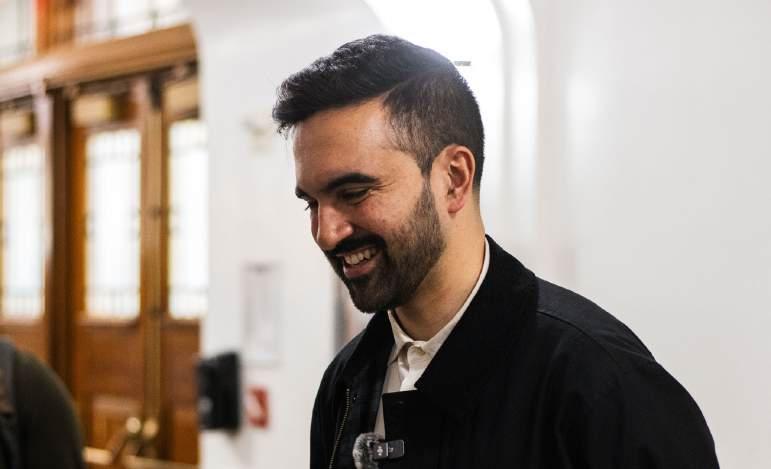
these off year elections during the first year of the Trump administration when people are really hurting. I think it also sends a signal that Democrats and especially young people are tired of the establishment that hasn’t been effective against Trump thus far! Of course elections aren’t everything and we should still keep our politicians accountable but I think this is also just so refreshing and a sign of hope in what’s otherwise a really dark time for a lot of Americans,” Lehman said.
The Young Democratic Socialists of America’s chapter at
Fordham, an unofficial student club, delivered a statement to the Observer on their reaction to Mamdani’s election.
“With this race, the people of New York City have ushered in a new era of socialist goals … New York City is not for bureaucrats and careerists, but for all New Yorkers. That is the coalition that Zohran has built … The Young Democratic Socialists of America are incredibly proud to have been a part of this historic campaign. (Democratic Socialists of America) has been at the forefront of Zohran Mamdani’s
candidacy since day one. … This victory brings much-needed hope and light to times that seem overwhelmed by hatred and darkness,” the statement said.
This election has also received national attention. On Nov. 3, Trump posted a Truth Social post that said, “If Communist Candidate Zohran Mamdani wins the Election for Mayor of New York City, it is highly unlikely that I will be contributing Federal Funds, other than the very minimum as required,” among a slew of other comments.
Critics of Mamdani have also
“Age of Incarceration”
pointed to his relative inexperience — as he has not served as an executive official — and questions over the feasibility of his policies.
Ballots were open from 6 a.m. to 9 p.m. on Nov. 4 — Election Day. Voting registration closed on Oct. 25, and early voting ended on Nov. 2.
This year saw the largest voter turnout for a New York City mayoral election since 1969, with over two million voters compared to the 2021 election’s 1.15 million. Voters cast a record-high 735,000 early ballots, many of which were from New Yorkers of a younger demographic. University students could register to vote in this election as long as they were not also registered in their home states.
Two mayoral debates were hosted leading up to the election, the first on Oct. 16 and the second on Oct. 23, with all three candidates present for both.
Alongside the mayoral election, Jumaane Williams was elected as the new public advocate and Mark D. Levine as comptroller.
Outside New York, Mikie Sherrill was elected as New Jersey’s governor and Abigail Spanberger as Virginia’s governor. Both are women and Democratic candidates. In California, Proposition 50, a redistricting proposal that aims to boost Democratic voter representation, passed.
New York City voters, and Americans nationwide, await what a Mamdani-led New York City will look like.
The most recent lecture of the Barbara L. Jackson Speaker series discussed systemic racism in schools and prisons, and proposed solutions for reform
By PARIS MATHUKU Asst. News Editor
Renowned scholar, activist and journalist Marc Lamont Hill criticized the racialized phenomenon of mass incarceration in America and called for prison and education reforms that prioritize rehabilitation over penalization at the 2025 Barbara L. Jackson Speaker Series at the Fordham Law School on Oct. 27.
Associate professor Liz Stosich, associate chair of Leadership, Administration and Policy at the Graduate School of Education (GSE), opened the event by detailing its history and discussing the continued impact of its namesake Jackson’s legacy.
“Dr. Jackson’s research and pioneering leadership elevating the role of women and people of color continues to have a profound impact on the field of educational leadership,” Stosich said.
Hill transitioned from Jackson’s legacy to the broader theme of the lecture: how educational institutions should be reformed toward rehabilitative, rather than punitive, disciplinary policies.
The relevance of mass incarceration is only growing. According to the Prison Policy Initiative, a nonprofit organization that works “to document and publicize how mass incarceration punishes our entire society,” the U.S. “imprisons more people per capita than any other independent democracy.” Contrarily, crime rates in the U.S. have decreased considerably since the ’90s. Hill clarified that this issue is divided on racial and gendered lines.
“America is not facing mass incarceration … but rather, mass
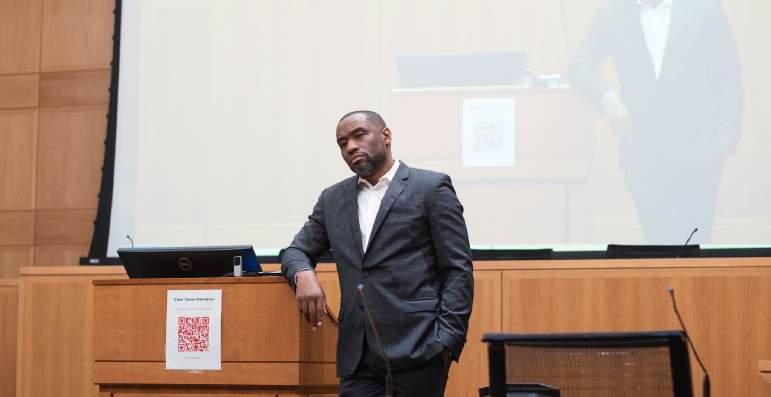
incarceration of the vulnerable …
One in 15 Black males and one in 26 Hispanic males are currently incarcerated … women are now the fastest growing segment of the prison population,” Hill said.
Hill said that modern U.S. prisons have cut back on rehabilitation programs, which often leads to repeated offenses.
“Access to reading materials, affordable phone calls to family, college degree programs, mental health resources — all of which are proven to reduce recidivism — have been stripped from many American prisoners,” Hill said.
Hill connected these realities to the world of education.
“Our most vulnerable communities have been rendered disposable by the very institutions designed to protect them,” Hill
said. “Instead of training grounds for democracy, too many of our schools have become little more than staging areas for the prison.”
Hill spoke to what he sees as an analogous reality between schools and prisons through increasing zero-tolerance policies and criminalization. He cited the presence of metal detectors and police officers in schools, and said he worries the increasing policing will lead to increased criminalization.
“Disciplinary actions once carried out by teachers and administrators are now being outsourced to local police,” Hill said. “Currently, two-thirds of high schools, half of middle schools and onefifth of elementary schools have a police officer — an armed police officer — in the building.”
Hill said these policies create
what he called “a pedagogy of criminalization,” which prioritizes “discipline, surveillance, isolation, punishment and exclusion.”
“The similarity between this scene and that of a prison is neither subtle nor coincidental,” Hill said. “From zero tolerance policies to punitive accountability measures to prison-level surveillance within the building, educational policy and school culture are increasingly shaped by the belief that order and control are the keys to success.”
Hill added that the intensity of policing at a given school is correlated to the number of students of color enrolled and pointed to the long history of the criminalization of Black people in America.
Acknowledging the proximity of these issues to people of color, the room had an audible reaction to the often-shared experience.
Hill then outlined a call to action for educators to embrace what he called “a pedagogy of abolition.”
“Rather than a pedagogy of criminalization, we must adopt a pedagogy of abolition,” Hill said. “Instead of asking, ‘Who did it and how do we punish them?’ we must ask, ‘Who was harmed and how do we make them whole again?’”
Hill emphasized that this reform requires imagination, calling on educators to have “unreasonable faith” in a better future.
“It is easier for many of us to envision the end of the world itself than to envision a world without prisons,” Hill said. “Freedom is always unreasonable within the logic of oppression … Like every successful freedom fighter before us, we must recklessly pursue the unreasonable until the unreasonable becomes inevitable.”
The event concluded with a question and answer portion, during which Hill was asked if he had seen successful examples of abolitionist education.
“I see in society pieces of abolition all the time,” Hill said. “When we look at progressive schooling visions that, as a policy, don’t suspend for truancy, that’s an abolitionist move … When we see restorative circles around con flict resolution in schools, that’s a major force.”
The event sparked hope toward a reformed society where schools are not pipelines to prison, but engines of democracy.
Heavy Rain Causes Flooding in Garden Level
Saxbys closed operations temporarily due to flooding from a rainstorm and adapts to new environment
“Nothing clogged on our end, nothing was put down the drains that there shouldn’t have been. It was purely, to my understanding — and again, Fordham’s doing their own report on everything here — purely the large amount of rain that came in yesterday,” Engelmann said.
Once Facilities Operations stopped the drainage, the Saxbys team cleaned, removed all food from the refrigerators which had been unplugged, and reorganized. An external company was brought in to perform a deep clean, according to Orla Fitzsimons, director of Dining Business Operations and Contract Management.
Jedd Applebaum, chief engineer and associate director of Facilities Operations, confirmed that the cause was the “ridiculous” amount of rain and said Facilities Operations has previously experienced issues during storms. He added that they are still brainstorming solutions.
“ This is (Saxbys HQ’s) first New York City café, so it was a new terrain for everyone coming in. ”
Aidan Engelmann, FCLC '26 and Saxbys SCEO
“We just did a walkthrough with our contractor plumber. … He’s coming up with options for us. This is something that’s been going on I guess for a while. We haven’t had a problem like this very often, but now we’ re trying to address it as best we can,” Applebaum said. “Usually it has occurred only during massive thunder showers.”
Saxbys re-opened on Saturday. Saxbys’ health and safety standards follow a combination of New York City Department of Health and Mental Hygiene (DOH), Saxbys, Aramark and Fordham guidelines, according to Engelmann.
“This is (Saxbys HQ’s) first New York City café, so it was a new terrain for everyone coming in. … We follow everything that both Aramark does in their other storefronts, along with what Fordham has recommended and New York City as well,” Engelmann said.
The café has not yet been visited by a health inspector, according to the DOH website. Saxbys is currently on the waitlist.
Engelmann and Fitzsimons said they were unsure when the official inspection would occur. Engelmann said the delay in inspection is “very normal for facilities within New York City because it is such a large area that they have to cover with very small staff.” Fitzsimons echoed this, attributing the delay to the DOH being “on catch-up from COVID,” and added that, prior to opening, the DOH approved the renovations and Saxbys’ operating permit. Restaurants around New York City have dealt with delays in DOH health inspections postCOVID due to budget cuts to the DOH and low staffing.
Oluwatoyin Akinfeleye, the sanitarian for Aramark at Fordham, has been conducting weekly site inspections since Saxbys opened. Engelmann walks through the café with Akinfeleye at each site inspection taking notes, and she provides recommendations for improvement.
Throughout the series of inspections, Saxbys has adapted and improved their operational
efficiency and health and safety policies, in accordance with recommendations from Akinfeleye, according to Engelmann.
During Saxbys’ most recent inspection by Akinfeleye on Nov. 4, Englemann said they “passed with flying colors” and received no suggestions for improvement.
The Observer was unable to obtain a copy of logs from any inspections.
Engelmann listed some of the new policies, including having team members wear a hair net and a hat, rather than one or the other, and removing all jewelry prior to the start of work.
Dalia Lundquist, GSBLC ’28 and a Saxbys team member, said she had not previously been aware of the policy on rings.
“Fordham’s health office had never informed us that we couldn’t wear rings … so we failed on it, but now we’ve improved a lot,” Lundquist said.
Saxbys will begin recording a temperature log for all meats to ensure they stay within a safe range. Engelmann clarified that these policies are not required by the DOH, but were recommended by Akinfeleye nonetheless.
Other new policies include placing covers on all trash cans and switching from using commercial dishwashing soap to sanitizing wipes. The latter switch was suggested by Costello to improve efficiency.
Engelmann also said that all Saxbys team leaders are certified with a New York City food protection card and through ServSafe, an online food handling certification system.
Lundquist pointed out that Saxbys is not an allergen-free café, as they cannot ensure there is no cross-contamination in the facilities of their ingredient suppliers.
Saxbys, having only been open for just over a month, is adapting to the strong student demand and addressing some growing pains that have arisen since its opening. Engelmann praised Saxbys’ success so far and said they are hiring new team members after some delays getting orders out in the initial weeks.
“We’ve had long lines and everyone seems really, really excited about it, which is great.
… We’re in the process now of bringing in new team members who are getting the team fully trained every weekend and just trying to keep up with the crowds,” Engelmann said.
“We are obviously getting faster and trending in the right direction, but I’d say that’s definitely been probably one of the largest challenges.”
Engelmann added that it was “always the plan” to start with a grand opening team, analyze sales after the first week, and then make a decision about hiring new employees accordingly. The hiring process is conducted by Saxbys HQ and Engelmann is not involved.
Fitzsimons shared a similar sentiment regarding the student response to Saxbys and said that the volume of transactions at Saxbys currently is higher than that of Argo at the same time last year. She attributed this uptick to Saxbys accepting meal swipes as a payment option and offering hot food.
Engelmann is also adjusting the quantities of ingredients he orders to avoid selling out of different items, but has experienced some small supply chain issues with invoiced items not arriving on time.
“Did I think that we would go through three gallons of whole milk in an hour? No. Never.
So, have I made many trips to


Target to try and get the whole milk back in stock? Yes, I have,” Engelmann said.
Engelmann said that the Saxbys employee handbook, which all employees must sign during onboarding, has a policy prohibiting its team members from speaking to the student press, with the exception of the student CEO.
“Are (DOH standards) rigorous? Are they sometimes challenging? Yeah, of course they are. But every single one is followed. And I know every team member will support that if you were to ask them and they were able to speak with you,” Engelmann said. “I brought it up to HQ and asked them if that was something that we could do … (but) only the student CEO is allowed to go talk to press.”
The Saxbys employee handbook states, “ Under no circumstance are unapproved Team Members to speak to the media on behalf of Saxbys.”
Engelmann emphasized Saxbys’ “rigorous” standards, particularly with respect to their closing shifts.
“In terms of closing, we have a pretty rigorous close. Obviously, because we’re on the basement level, we’re a café, so we do store food in the back. So everything must be sealed, everything must be enclosed that can attract any sort of pest or roach or anything like that,” Engelmann said.
Fitzsimons shared that there was a mouse sighting in Ram Café.
“We doubled into our pest control and they were on site every single day getting on top of the issue,” Fitzsimons said.
Ram Café’s last DOH inspection in Dec. 2024 received an A grade alongside two sanitary violations. These included that Ram Café was not “free of harborage or conditions conducive to rodents, insects or other pests” and contained flies or “food/refuse/sewage associated with flies.”
“ And then about a minute later … (my friend) is like, ‘Is that a mouse?’ And they point to the opposite direction, and so there are multiple mice … a little concerning, for sure. ”
Johnny DiLorenzo, GSBLC ’28
Johnny DiLorenzo, GSBLC ’28, said he and a friend saw two mice on the evening of Nov. 3 in the Garden Lounge, which then climbed into the vents.
“I’m trying to get some work done … and out of the corner of my eye, mid conversation, I see (a mouse) … and it climbs into the side of the wall,” DiLorenzo said. “And then about a minute later … (my friend) is like, ‘Is that a mouse?’ And they point to the opposite direction, and so there are multiple mice … a little concerning, for sure.”
A work order was placed for the four mice spotted in the
Garden Lounge that night, and Facilities Operations responded that they had put down traps.
This is not exclusive to Lowenstein. The Office of Residential Life (ORL) was recently notified of rodent sightings in the residential halls, according to Fitzsimons and Director of Residential Life Kelly Sosa, who oversees all student resident assistants (RAs) and resident first-year mentors (RFMs).
“A student/suite shared their concern with a RA, who immediately escalated the issue to their supervisor, allowing Residential Life to respond promptly,” Sosa said. “Following standard protocol, the student was asked to submit a work order, Facilities conducted an assessment, and an exterminator was subsequently contacted.”
There were two reported cases in residential spaces. Sosa said the situation “is not considered an ongoing issue. However, the recent drop in temperature has contributed to the problem, as rodents tend to seek warmth and food sources indoors during colder weather.”
Fitzsimons added that another potential cause is the circus at Lincoln Center, which “upsets (the mice’s) habitat.”
Fitzsimons spoke at an RA-RFM meeting on Oct. 28 to explain the situation and review procedures for RAs and RFMs to best support students should they encounter rodents.
Sosa instructed students, should they see a rat, to submit a work order, after which Facilities Operations will assess the space, set traps and coordinate with an exterminator if necessary.
Sports & Health
Science Says Studying Burns Calories
By CATHERINE RAIMONDI
Contributing Writer
Do you feel your brain getting tired while studying? Do you get hungry while studying at night? Do you feel your brain growing as you feed it information? This is because learning is a form of exercise. Learning is to your brain what squatting is to your legs and bench pressing is to your arms.
Proper nutrition for the brain is often overlooked, as using the brain is not necessarily deemed a workout. However, with the amount of energy your brain requires to tackle the workload at Fordham, it is imperative to start treating studying like a physical exercise.
Your brain exhibits many of the behaviors of a muscle. Although not officially considered a muscle of the body, it is important to treat your brain as if it were one, especially if you want it to exhibit the same productivity as a muscle.
Repetition for your brain is similar to crunches at the gym. Flashcard sets, for example, create mental stimulation. This is due to the brain’s neuroplasticity. When learning, your brain is stretching and growing neurons to preserve that information for future use.
Sarah Kahl, Fordham College at Lincoln Center (FCLC) ’29, says she can feel her brain exerting itself while studying.
“Sometimes I feel like (studying) is more tiring than physical exercise,” she said.
Just like exercise, your brain burns calories while you study. The brain requires metabolic activity to perform its functional processes properly. Studying requires an increased transmission of neurotransmitters, which
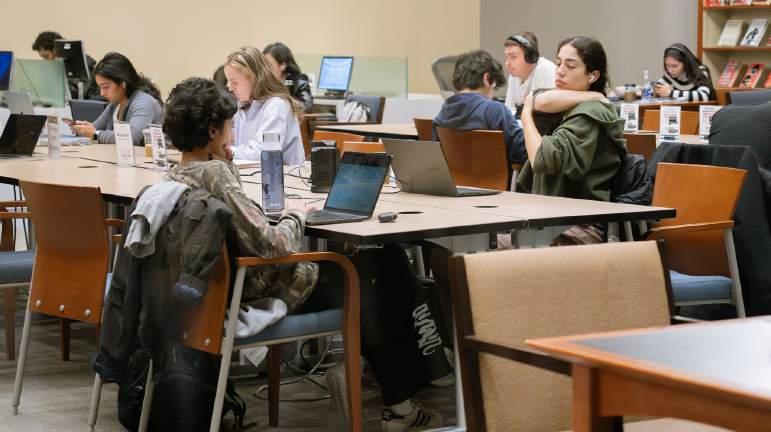
intensifies metabolic activity; calories and oxygen rates are increased throughout the body, yielding similar results to those you experience when you exercise. Due to the effects of metabolic activity in your brain, proper nutrition is crucial. Protein and hydration support your body for long runs and gym sessions. These same nutritional supplements are needed after a long study session. Protein is essential for fueling the brain, especially when studying. The neurotransmitters are built from amino acids, which are produced by breaking down proteins. When properly fueling your body with protein, the activity of neurotransmitters is enhanced.
Valery Coronel, FCLC ’29, sees a direct correlation
between eating healthily and academic performance.
“When I eat things that are heavily processed or have more carbohydrates and less protein, I feel foggier, and when I eat fish or protein, before tests especially, I feel like my brain is clearer,” Coronel said.
There are many on-campus dining options that allow students to fuel their bodies and brains appropriately.
At Fordham Lincoln Center, one option is Saxbys, the student-run café in the 140 West 62nd Street Building. They offer specific menu items that can increase protein consumption. Saxbys’ Fit Frolattes offer 22 grams of plant-based protein. They come in two flavors: matcha and cold brew. The Cold Brew Fit Frolatte, along with its
protein, can also provide you with caffeine to help boost your energy levels.
Protein consumption is also associated with serotonin levels, a neurotransmitter that impacts mood, sleep and appetite. Increased levels of serotonin can further enhance your attitude and keep you motivated while studying.
Other eateries on campus also offer highly nutritious options.
Each dining hall posts the nutritional information of the food it serves, ensuring that you can make healthy choices when you eat.
Freshens at Ram Café offers a variety of high-protein options.
The Protein Power Grain Bowl offers 38 grams of protein. Its ingredients, according to the Ram
NYC Marathon Breaks Records
To enter the marathon, in addition to an entry fee, participants must select an NYRR-partnered charity to raise a threshold amount of money for.
For Ash, Fordham College at Lincoln Center (FCLC) ’28, this was her first marathon. She spent 18 weeks training and over a year fundraising for Team for Kids.
Asking for donations was initially daunting, Ash said, but she quickly found that people “were so into it, and they were all so generous.” Although the qualifying amount for Team for Kids was $3,000, Ash raised around $3,500.
Almost as famous as the marathon itself is the buzz that it brings to New York City. Throughout its length, participants are surrounded by friends, family and eager onlookers.
“I’m so excited to see the energy and having people cheering for my name,” Ash said ahead of the race.
She kept her goal time a “secret” to prioritize the marathon as an experience rather than a competition.
“I literally cried so many times. Every time I saw someone, I was so emotional; it was just so crazy it was actually happening,” Ash said. “Everyone cheering for strangers — that’s just kind of a crazy experience.”
This was also the first marathon for Run@LC E-board
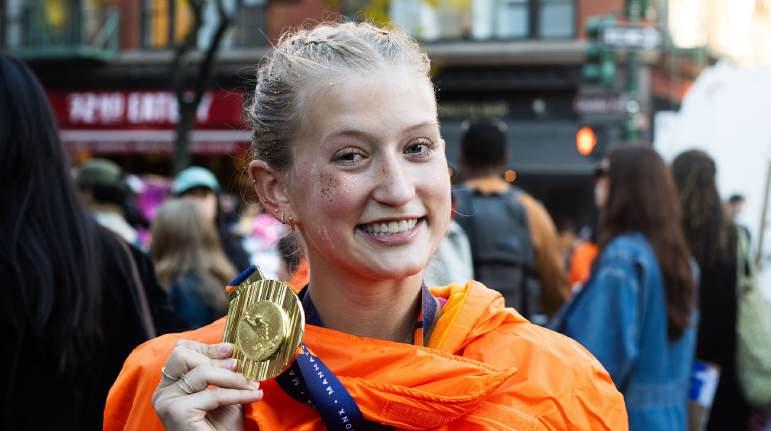
member Valerie Ramirez Salgado, FCLC ’28, and the task at hand did not inhibit her enthusiasm, either.
“I’m seeing all the TikToks and it sounds so fun. It’s like, ‘Oh wait, that’s gonna be me,’” she said prior to the race.
Salgado was introduced to running and granted entry to this year’s race by an NYRR partner program, Run for the Future, which she joined in high school. The program’s goal is to empower young women to run, and for Salgado, she “just continued running nonstop” after joining.
She is already qualified for next year’s marathon through the NYRR 9+1 Membership Program, which dictates that if you run nine NYRR races and volunteer for one, you have guaranteed entry rather than having to fundraise or enter a lottery.
Salgado found some of the fun she was looking forward to even before the race began. On the ferry to Staten Island and at the start village, she spoke with several other participants.
“It really is like that one big block party (for) the entire city,” Salgado said.
Café menu, include “chicken, black beans, egg, bacon, cheddar jack, lettuce, buffalo, ranch dressing, brown rice and quinoa blend.”
Proper hydration is also crucial for fueling the brain when processing new information. Studies have linked increased hydration to better memory and attention. Water is also important for studying, as it can serve as a healthier alternative to malnutritious, sugary energy drinks. Although the rush of caffeine may feel good in the moment, water is a better choice to pair with studying, as it is better for sustained focus and optimal cognitive performance. Caffeine can only last you so long before you experience a crash, whereas water will keep your mind fresh throughout the day.
It is recommended that college-aged students drink 72 to 104 ounces of water per day, depending on their weight and sex. For the average person, that is about four Owalas, five Hydroflasks or three Stanleys of water.
Coronel said that she fills her water bottle “four or five” times a day, and that she notices hydration “100% helps when (she) studies.” Filtered water fountains are located on each floor of the Leon Lowenstein Center, as well as many of the study lounges. It is easy to remain hydrated while on campus.
Overall, Fordham offers you plenty of options to ensure you are properly fueling your brain during your studies. With an intense workload in college, it is essential that you optimize your brain’s performance. If you want your brain to run the marathon of cramming for final exams, treat it right!
She was brought to tears by her family who were stationed at several points along the course, including in the grandstands that overlook the finish line. Schirmers, FCLC ’27, the president of Run@LC, participated in the New York City marathon for the first time this year, qualifying through the 9+1 Membership Program. Although it was not her first marathon, she said it was nothing like the one she completed in her hometown in Minnesota. She only took a week off of training after her first before beginning
another 18 weeks of training.
“Everything I eat, what time I wake up, what time I go to bed, I’m always thinking about running the marathon, and then all of a sudden it just ends,” Schirmers said days out from the race. “A lot of people go through a post-marathon depression.”
Salgado said that she felt some “post-marathon blues” herself.
“After having a set training block for so long now, it’s like this week, I basically just do nothing,” she said. “What do I do now?”
For Schirmers, running has always been a crucial community builder. Coming to college after being on a local running team for six years, she struggled to find a sense of community until she joined the Upper West Side Run Club. Her peers in the club were cheering her on, along with her family and her boyfriend.
“It’s just the most selfless act to go out and watch strangers run. Even if you’re there for somebody or one of your friends is running … my parents waited 40 minutes to see me for 10 seconds when I ran past,” she said.
The turnout for the marathon this year was impressive, but its energy alone was palpable. The next TCS New York City marathon is about a year from now, but it might already be time to start fundraising.
As Schirmers said, nobody should “feel like they’re not a runner enough to run the New York City marathon.”
Wading Through Instability: Thoughts on Anxiety
Exploring the relationship between humanity’s search for truth through literature and science
By JACK BRUDECKI Fact Checker
In two sentences, Chilean author Benjamín Labatut manages to describe the shared telos of art and science with devastating elegance. He does so through the voice of German physicist Karl Schwarzschild, along with other 20th-century scientists and mathematicians.
“Is there anything that is truly at rest, stationary around which the universe revolves, or is there nothing at all to hold on to amid this endless chain of movements in which every single thing seems bound?” Labatut’s fictionalized Schwarzschild says. “Just imagine how far we have fallen into uncertainty if the human imagination cannot find a single place to lay its anchor, if not a single stone in the world has the right to be considered immobile!”
This was one of the countless quotes that gave me pause in Labatut’s book “When We Cease to Understand the World,” a blend of fiction and biography that tells the stories of various important thinkers from the 20th century. I begin with this book because I believe that this quest for a stable foundation is a desire that underlies mental well-being. Put another way, at the core of human experience exists a close connection between mental health and the desire to understand.
“
The insights gained from quantum physics suggest that what psychology has unearthed about the human mind could apply to a singular, unified consciousness.”
Alan J. Steinberg, Psychologist
Both Labatut and I are far from the first people to posit this connection between higher-level physics and mathematics with human cognition. To explain
the correlation, it is necessary to dive into a short introduction to quantum physics.
In an article for Psychology Today, Alan J. Steinberg said “the insights gained from quantum physics suggest that what psychology has unearthed about the human mind could apply to a singular, unified consciousness.” The insights to which Steinberg refers are based on three principles of quantum physics: The first is that observable objects exist in a virtual state of potentiality until the moment an onlooker observes them, the second is that the entire universe is interconnected across space and time and the third is that an observer is a necessary component of the universe. In other words, subatomic particles like electrons are in an indeterminate state called a superposition, which “rapidly collapse(s) into definite states when interacting with the environment,” a Science News Today article explains. Essentially, quantum physics studies the instability present in every atom, and at the root of every thing.
Scholars Diogo Valadas Ponte and Lothar Schäfer connect quantum physics with Carl G. Jung’s psychoanalytic framework of a universal unconscious. This comparison begins with a note that “the basis of material things is not material.”
“In contrast to their appearances, the electrons in atoms and molecules aren’t tiny material particles or little balls, which run around … the atomic nuclei like planets around the sun, but they are standing waves: when an electron enters an atom, it ceases to be a material particle and becomes a wave,” the authors write. “That is, the electrons in atoms are probability fields.”
By “probability fields,” the authors mean that electrons are equally present at numerous locations within an atom at a given moment. They occupy a superposition rather than a singular location prior to measurement. By definition, this concept is incompatible with our human horizons of understanding.
Ponte and Schäfer go on to parallel these ideas in quantum cosmology in saying that “this
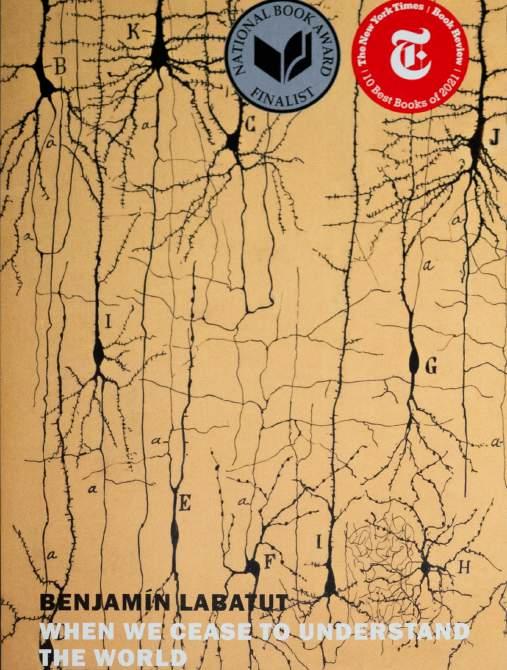


I recommend checking out these
quantum view of a holistic reality is in perfect agreement with one of Jung’s most important, seminal ideas; that is, the archetypal idea of Unus Mundus.” The authors quote Jung’s description of this archetype: Jung writes, “undoubtedly the idea of the Unus Mundus is founded on the assumption that the multiplicity of the empirical world rests on an underlying unity, and that not two or more fundamentally different worlds exist side by side or are mingled with one another.”
All of this is to say that imprecision, uncertainty and the unknowable lies at the heart of many spheres of human intellectual labor. On the one hand, it could be argued that this unreachable data is cause for anxiety; as humans, we can only peel back the intellectual onion that is the world so far, only to be left with a piece so infinitesimally small that it becomes impossible for us to separate another layer. But this is only a single interpretation, one of the many possible positions this idea can be found to take — just like electrons.
To circle back to Labatut’s writing — and to justify the presentation of these scientific viewpoints to begin with — I’d like to walk through one of the vignettes in his novel. “The Heart of the Heart” follows the intellectual history of German-French mathematician Alexander Grothendieck, who is widely regarded as one of the greatest mathematicians of the 20th century.
Labatut introduces Grothendieck himself as having “towered over mathematics like a veritable colossus.” Like Jung and countless thinkers both before and after him, Grothendieck’s quest was one for coherence: The Institut des Hautes Études Scientifique, where Grothendieck worked from 1958 to 1970, describes his work as an “ambitious program
if you
of fusion between arithmetic, algebraic geometry, and topology (that) continues to structure contemporary mathematics.”
“He formulated his ideas by removing one layer after the other, breaking down concepts, simplifying and abstracting until there seemed to be nothing left,” Labatut writes. “There, in that apparent vacuum, he would discover the structures he had been searching for.”
His intellectual project culminated in the pursuit of uncovering “the secret root that could bind together countless theories that bore no apparent relation to each other,” as Labatut puts it. Grothendieck referred to this pearl as “the heart of the heart.”
“ He formulated his ideas by removing one layer after the other, breaking down concepts, simplifying and abstracting until there seemed to be nothing left.”
Benjamin Labatut, Author of “When We Cease to Understand the World”
But his ascent did not continue perpetually. Labatut describes the stark changes Grothendieck underwent in the political climate of Paris in the late ’60s. Labatut writes “during his talks, (Grothendieck) gave away apples and figs grown in his garden and warned about the destructive power of science: ‘The atoms that tore Hiroshima and Nagasaki apart were split not by the greasy fingers of a general, but by a group
of physicists armed with a fistful of equations.’”
The idiosyncratic genius turned his attention inward, away from the structures of mathematics. Grothendieck increasingly isolated himself, the motivation for this being detailed by Labatut, writing “his isolation was … for the protection of mankind” but Grothendieck “refused to explain what he meant.”
The Icarian journey of Grothendieck’s life as rendered by Labatut follows the epiphanic rise and disastrous fall of each vignette. Every protagonist is heroically toiling at the greatest scientific and intellectual problems with which humankind has gotten acquainted. The link between ingenuity in search of understanding and mental disorder is a powerful construction — one that demands further analysis.
In its entirety, Labatut’s book remarks that barriers to rational understanding are inevitable. These obstacles, however, do not bar us impotent creatures from trying to pierce through them, then suffering when we find they are impenetrable.
I chose to talk about this work of literature because I feel as though experiences of instability — of an inability to comprehend that which one encounters — is not only common; it is a fundamental feature of the material world. If there is anything to take away from the all too brief introduction to quantum mechanics, it is that as distances grow smaller and smaller, the usual manners in which we engage begin to break down. It is not a question of if our understanding will cease, but when. The inevitability of our lack of understanding should comfort us — anxiety is unavoidable, but it is understandable given the ever-shifting nature of the world around us.

Holding Space for Everything ‘Wicked’ with Gregory Maguire

The author of the 1995 novel spoke at Fordham ahead of the release of “Wicked: For Good”
By MORGAN JOHNSON Online Editor
“Wicked” author Gregory Maguire made a rare public appearance at Pope Auditorium on Thursday, Oct. 23 for a talk hosted by Fordham’s Center on Religion and Culture about “Wicked,” spiritual and creative life, and his latest novel “Elphie.”
Before the event, students, faculty and guests formed a line that wrapped around the Lowenstein lobby into the tunnel hallways in hopes of receiving a copy of “Elphie.” The talk was orig-
“Wicked: The Life and Times of the Wicked Witch of the West” in 1995 at the age of 41, the book was not an instant success. Maguire referred to the novel as a “sleeper hit” that slowly gained popularity. His patience was rewarded with Stephen Schwartz’s Broadway musical adaptation and Jon M. Chu’s movie adaptation — 30 years later, “Wicked” is everywhere.
Writing about the Wicked Witch of the West was not Maguire’s first idea for an adult novel. He was initially focused on the power of language to invoke and justify violence. When living in London
“Everybody knows who the Wicked Witch of the West is. Nobody knows why she’s wicked. She doesn’t even have a name. They just call her with a capital ‘W’ Wicked,” he said. “And I thought, ‘There’s the answer to my question about who is an evil person. If I write about this character, I will be able to go anywhere I want with her because I have studied.’”


support, while her father favored her younger sister Nessarose. Still, Elphaba remained a curious child whose intellect continued to flourish.
“ You can’t abandon her. And you can’t use her. You can’t hijack her life to prove your intellectual points about what moral monsters are.”
Gregory Maguire, Author of “Wicked”
Exploring the Wicked Witch of the West gave Maguire a new sense of freedom because he no longer had to remain historically accurate.
In Baum’s “The Wonderful Wizard of Oz,” the Wicked Witch of the West was the villain of the story, while Dorothy was the protagonist. Readers never truly know the Wicked Witch of the West’s motivations for wanting to steal Dorothy’s silver slippers or why she rules Winkie Country and has an army wwof animals.
The 1939 film adaptation “The Wizard of Oz” is largely the same. While it fleshes out the Wicked Witch of the West’s vengeful quest against Dorothy — Dorothy killed the Wicked Witch of the East and took her ruby slippers — her character is still undeveloped. There’s a motive for her vendetta against Dorothy, but she is still portrayed as inherently wicked.
Maguire sought to change the Wicked Witch of the West’s narrative from a one-dimensional vengeful villain to a three-dimensional person with a name — Elphaba. By doing this, Maguire honors Baum’s original characters while also making them his own.
“I tried not to besmirch. I tried not to make too much fun of any of them. I tried to make them even recognizable to admirers of the 1939 film and of the novels, but I still made them more complex characters, all of them, than they were in the children’s stories,” Maguire said.
Maguire’s initial intention was to present Elphaba as a wicked figure because that was what he wanted to do with his original idea about Hitler. As Maguire continued to write, especially about Elphaba’s early childhood, he realized her humanity despite her monstrous green fea tures, which she had no control over.
At 17, Elphaba left home to attend Shiz University, where she roomed with Galinda Upland — soon to become Glinda. At Shiz, Elphaba’s curiosity was her greatest asset as she became an assistant to Dr. Dillamond, a Goat professor, who was researching the difference between humans, animals and talking Animals to fight for animal rights.
The discrimination against Animals awakens Elphaba to social injustice.
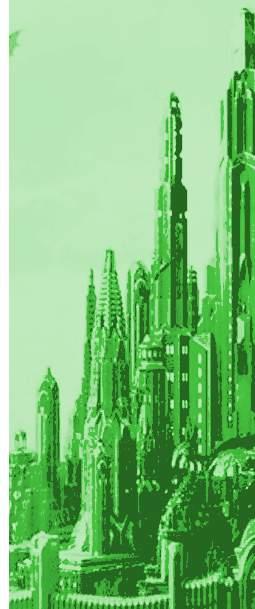



“You can’t abandon her. And you can’t use her. You can’t hijack her life to prove your intellectual points about what moral monsters are,” Maguire said.
“Instead, you have to be a jour nalist … you just have to follow behind her in her life … you owe it to this human creature to allow her to live her life in some amount of freedom. And don’t make her carry your burdens. Make her live her own burdens and record them.”
“Wicked: The Life and Times of the Wicked Witch of the West” does exactly what the title suggests. During Elpha ba’s youth, her family was ashamed of her green skin and she was socially ostracized. Elphaba found com fort in her nanny, a Bear who provided her love and



because of the subtle changes and complexities and the foreign aspects of the magic world.”
Angela O’Donnell, English professor and associate director of the Francis and Ann Curran Center for American Catholic Studies, connected Maguire’s genre of fantasy with a spiritual exercise of imagination.
“When you write fantasy, you get to create a new universe. That’s what God did, right?” O’Donnell said. “It allows for fresh understanding and envisionment of the human condition and the human circumstance.”
When it came to optioning his novel for adaptation, Maguire kept an open mind. He believed in giving the adaptor freedom as long as they understood why he wrote the novel, and he wanted people to have the same freedom he did when adapting from Braum’s original novel.
“As long as you have persuaded me that you know why I wrote this book. Then you use the skills at your disposal to make it into the best story you can. What you leave in, you leave in; what you take out, you take out,” Maguire said. Schwartz sold Maguire on his vision for a “Wicked” musical one afternoon in Connecticut. During their discussion, Maguire recounted how Schwartz said, “You have to picture this on a bers. If somebody steps to the front of the stage and the music comes up …
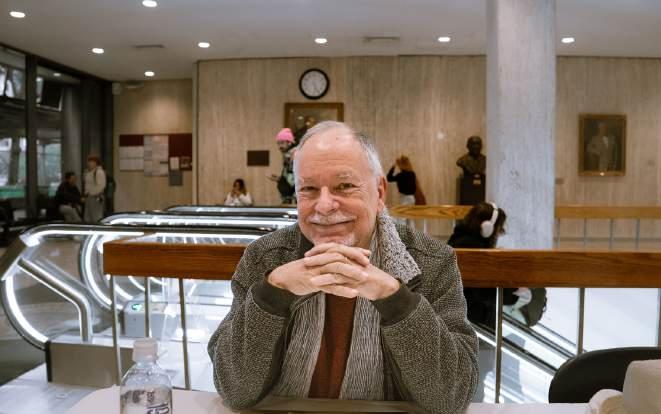
just comply all the time with these limitations,” O’Donnell said.
Maguire spoke about how he was inspired to write from his experiences within the Catholic Church and how readers have different experiences that influence their understanding of the story.
“We are shaped and formed by the forces against us,” Maguire said. “In ‘Wicked,’ particularly, but then following through all the other books … I wanted Oz to represent the world in which we live as this immense complexity of conflicting understanding systems.”
“Wicked: For Good” has ample room to expand on Act Two of the musical, which is approximately 45 minutes long. The film should pick up directly after “Defying Gravity” and Elphaba fleeing the Emerald City without Glinda.
At the beginning of the talk, Maguire noted that he has avoided anything “Wicked: For Good” related, whether it was trailers, teasers or the “Dancing With the Stars” “Wicked”-themed night. He wants to go in blind.

song title for the opening scene: “No One Mourns the Wicked.” To that, Maguire said, “I could tell that he knew why I had written that book.”
“No One Mourns the Wicked” contains the central themes of the novel, play and movie, which are encapsulated in Glinda’s line, “Are people born Wicked? Or do they have Wickedness thrust upon them?”
primarily been played by white actresses over the years. This year, Lencia Kebede stars as Elphaba in the Broadway production of “Wicked,” making her the first Black actress to assume the role full-time in the play’s Broadway history.
The casting of a Black actress adds even more weight to Elphaba’s story,
For emphasis, Maguire moved downstage and began singing a rendition of “The Wizard and I,” which he remembered “Unlimited. My ited … I just had a vision almost like a prophecy. I know it sounds truly crazy. True, the vision’s

“ I wanted Oz to represent the world in which we live as this immense complexity of conflicting understanding systems.”
Gregory Maguire, Author of “Wicked”
Glinda’s line raises a similar ques tion to the one Maguire asked himself when writing Elphaba’s story. He needed to remember her humanity first, rather than the title that she has been given.
The musical opened on Broadway in 2003. The music was written and composed by Schwartz and the script by Winnie Holzman. Menzel and Kris tin Chenoweth originated the roles of Elphaba and Glinda. The original pro duction was nominated for 10 Tony Awards in 2004 and won three —“Best Actress” for Menzel, “Best Scenic Design” and “Best Costume Design.” The musical is the fourth-longest-running show on Broadway and has made over a billion

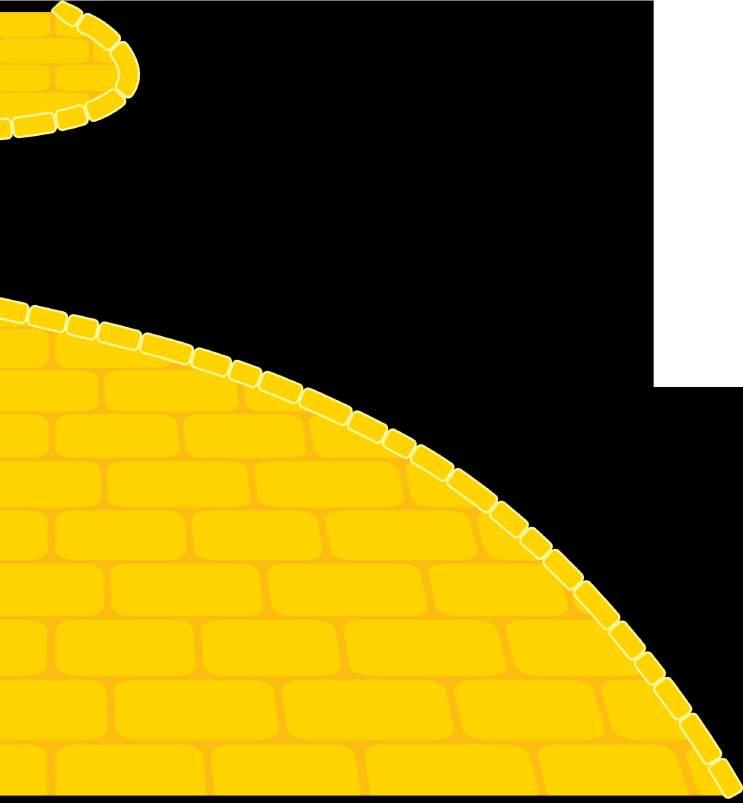
When part one of the “Wicked” movie began its roll-out, Maguire said he had watched everything leading up to the premiere.
“I felt I had seen design elements of every single scene released in the trailers … By the time I got to the movie, I felt like I’d sort of already partly digested it,” Maguire said.
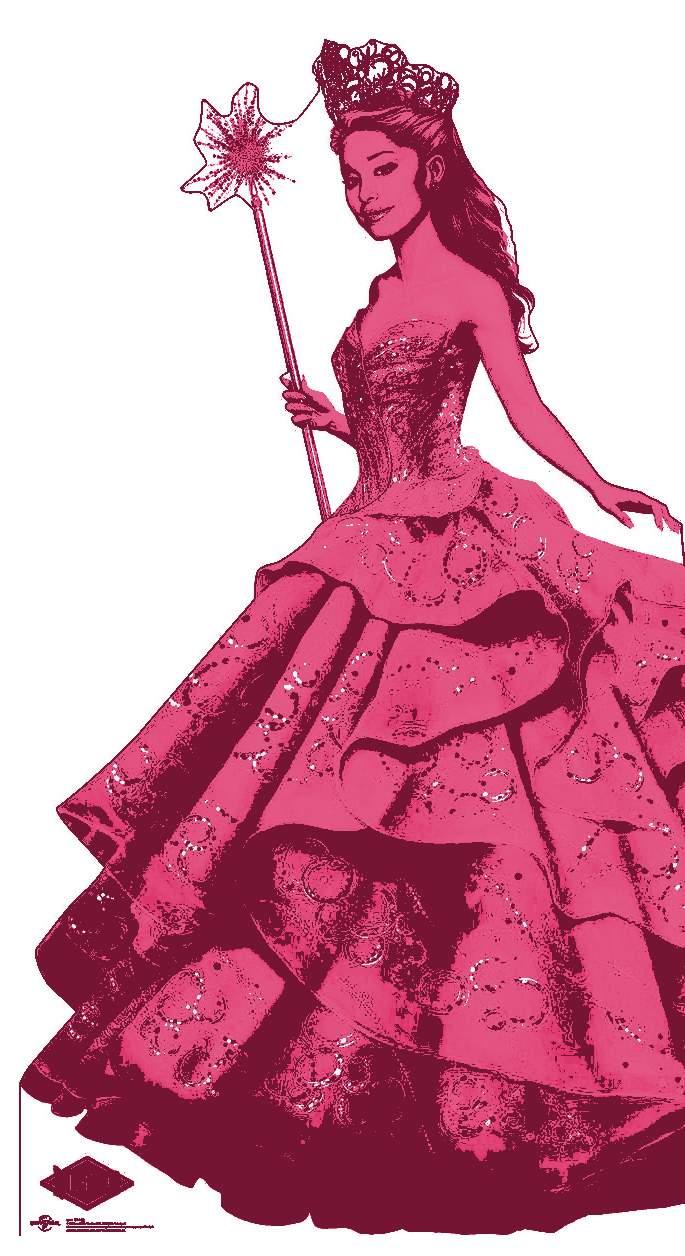

Most people like birds. After all, birds are everywhere — on the street, in parks, stealing your lunch at the beach — and they are very charming. Few other animals have adapted so well to living with humans, and in turn, we’ve grown very fond of their presence.
It’s no wonder, then, that over a third of Americans self-identify as birdwatchers. You’re probably a birdwatcher too, even if you don’t know it. Watched a huge flock of pigeons take flight from your office window? Snapped a photo of a pretty red bird in a courtyard? Pointed out a nest on a telephone pole to your family? That’s birdwatching.
Only known to the most devoted fanatics, however, is an even deeper layer of bird appreciation: birding. A birder rises at dawn, squats down for hours in the freezing cold or blistering heat, and notes every bird they see to the tiniest detail. They obsessively update their “life lists,” keep tabs of any potential rare sighting and know every bird by sight. At least, that’s what the most intense birders would tell you.
For me, though, birding is just a step up from birdwatching. I’m not an expert by any means, but I would consider myself a birder because I like to learn more about birds. It’s relaxing to stroll through the park with my binoculars or try to identify a bird flying by. I think if you’re already looking at birds anyway, you might as well become a little bit of a birder. At the very least, when you’re tuning out of class by looking out the window, it’s gratifying to know the name of whatever’s hopping around out there.
For starters, birding costs very little. If you desire, you can bird with only your eyes, but most people at least use a pair of binoculars. Like most hobbies, you can spend thousands of dollars on the most premium equipment — binoculars, scope and camera — but none of that is necessary. The birds themselves are free, as are most parks and wildlife refuges. For the same reasons, birding is also very low-tech, requiring little interaction with your phone in the moment. In fact, birding requires full concentration from both your eyes and ears, making it incompatible with the use of technology.
In this way, birding is an excellent way to unplug. Like the rest of my peers, I spend nearly all my time on my laptop or phone, and birding is one of the only ways I can drag myself away. Not only is there a proven positive correlation between mental health and being outside, there’s also one between mental health and birdwatching specifically! “Touching grass” — also known as going outside — is, at least for me, easier to do with the goal of birding in mind. Birding walks have also helped me regain some of my attention span — I’m not so dedicated as to wait for hours in one spot like other birders, but even just forcing myself to pay attention to my environment has helped me be more present.
You might be wondering: Can you even bird in New York City? Sure, there are pigeons and sparrows mulling around, but do you even have a chance of seeing anything else?
In fact (and this isn’t just city patriotism), New York City is one of the best places to bird in the United States. Every large park in the city — Central Park, Prospect Park, Riverside Park, Hudson River Park and more — is host to thousands of migrating birds throughout the year.
For me, the key part of birding isn’t just traveling to see birds, but seeing them as I embark on my regular walks in the city’s nicest areas. Originally, I only began to take walks around the city to avoid my cramped McMahon dorm, until a chance encounter at Hudson River Park transformed me into



a birder. My “spark bird,” the bird that turned me into a full-fledged birder, was a little sandpiper shuffling along the rocks. I was so captivated that I might’ve spent an hour just staring at it, watching the bird pick at rocks for food — I was hooked. Ever since, I’ve developed a habit of walking near the water just to look for other sandpipers. If you’re already strolling around, you might as well keep an eye out, since you never know what you’ll find.
And once you start recognizing the birds you find, you start noticing when a bird is unusual. Then, the more you find, the more birds you’ll want to see until you, too, start keeping track of every new species. All of a sudden, the differences between a Nashville warbler and the rarer mourning warbler (which, to the untrained eye, are both just small yellow birds) become obvious. Who wouldn’t notice the slightly greyer tint of the mourning warbler’s face, or the pinker hue of its feet? Even the sight fills us birders with awe. There’s a special rush when you see a rare bird and a satisfaction in knowing you’re one of the few around who appreciate it. It’s like the bird is appearing just for your pleasure.
This enthusiasm gives birding a reputation of being lame or only for retirees. While it’s true the median age of dedicated birders is relatively high, the hobby itself has become very trendy.
In fact, birding has been named the “hot-girl hobby of the year” by lifestyle media company Popsugar. Receiving this esteemed honor opens birding up to a much younger audience than before. Speaking anecdotally, I see a lot more people my age seriously birding now than I did just a year ago. Even (and maybe especially) with just the oldheads, though, the birding community is very welcoming. Ask anyone with binoculars what they’re looking at in a park, and they’ll always try to point it out for you; birders are relentlessly friendly people.
A large part of the appeal for many birders is the sense of community, as New York City birders are a tight-knit community, but one always open to more bird-lovers. Even passing by other birders, there’s a sense of fraternity that is difficult to find in most other hobbies.
I recommend a little bit of birding to everyone. If you already like birds (which, statistically, you probably do), there’s no reason not to just go a step further. No need to stalk a sparrow in the bushes for hours or fanatically chase down a wayward warbler. All you need is an online guide (Merlin Bird ID is best), a pair of sneakers, maybe some binoculars and the willingness to try. Just paying a little more attention to the birds and places around you can make a world of difference.

Former Asst. Arts & Opinions Editor
As children, we are often friends with everyone. We have not yet learned caution, and our zest for life is newfound. So newfound, in fact, that we have next to no concept of difference, of binaries, of all the things that rule the adult world which we find so dreadfully boring and foreign. All we know is an insatiable desire to play, to imagine, to make believe. Communion comes readily.
When otherness is introduced to us, that ardor is dampened. Let us not forget that before we were boys and girls, we were children. Cooties do not exist when you cannot spell your own name, and so we were a collective, united by our shared ignorance of all that is horrible. We communed with unfettered adoration and imagined with great and beautiful zeal. However, this utopia devoid of distinction could never last forever. We were promptly escorted into our decided genders, and so the line between our desires and the demands of society blurred into intelligibility.
To be a child is to live entirely at the mercy of those around us. It is to be a damp block of clay on the spinning wheel of life. When we are young, there is little concept of free will — ideally, our guardians dress us, feed us and take us to the places we need to go. We do not have much of a say in these matters, and, for a moment, we do not need to. It is during this time that we are the most vulnerable to the notions of adults who hope to mold us into “functioning members of society.”
As we begin to mature, adults impose upon us their impressions of boyhood and girlhood, these abstract realms through which one must traverse in order to grow up. They wait for us with open and eager arms, ready to deliver us to bigger versions of ourselves.
And that is where the problem lies. There is an assumption, sometimes voiced and other times implied, that gender as we know it is wholly natural. That the categories that we fall into are solely dictated by some intrinsic inclination. Yet, deep down, we must know this to be inaccurate. Do not misunderstand me; I do not deny the existence of biological sex. What I instead wish to dispute is this avowal that gender, the constructed notions that influence our conceptions of the masculine and feminine, is inherent.
How can we believe this when gender typing often penetrates the womb long before we are born? The sex of a fetus can be discerned via ultrasound as early as 18 weeks into the pregnancy, and should the parents choose to be informed, they often act accordingly. When they configure a baby shower registry, decide what color to paint the bedroom, or better yet, slice into a cake whose color will announce one’s sex to the world, they are actively imposing a set of expectations upon their unborn child.
This is not an inherently evil thing, but it would be foolish to assert that it has no effect on the development of a child’s interests, preferences and behavior. It would also be unjust to place the sum of this blame on the parents who are simply trying their best to give their baby a fighting chance in a formidable world.
Parents play a big role in this, yes, but nobody can exist in the vacuum of their guardians’ love for long. Long before we venture beyond our doorsteps, the outside world sneaks in to forge us in its vision. Through
Platonic Intimacy Can Save Us
While constructions of gender divide us, we cannot let them rule us

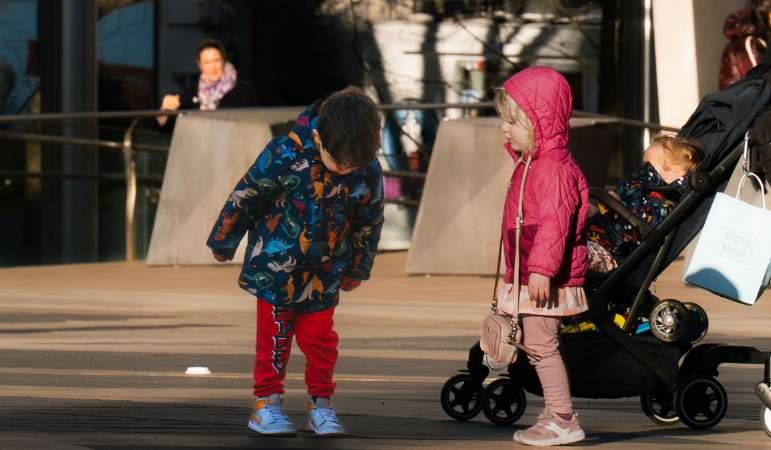

the inescapable advertisements that line every street and adorn every store, we are being told not just what to buy, but how to be. And the imagination that I spoke of earlier, that hallmark of childhood, is funneled into gender-specific domains that curate our interests and shape our perspectives. We are told what and who to play with, what to wear and how to wear it. Our toys, the vehicles of our blossoming imaginations, are partitioned into pink and blue bins, and we are ushered into our respective flocks. When boys play with dolls — forgive me — action figures, they are shown a vision of what they ought to become: strong, bold, brute. They are presented with the image of perfected masculinity, and so they
aspire to that celebrity. Girls, on the other hand, are often showered with contraptions of motherhood. Baby dolls with parted plastic lips and bottles to match are bestowed upon them. And with these rubber counterfeits of infancy bouncing on their hips, girls learn that the best thing they can become is a mother. Before they have the chance to become their own person, they are already being taught that the creation and construction of another is a more worthy pursuit.
When examining this, it becomes clear that ideals of masculinity and femininity are antithetical, and with boys and girls striving towards such conflicting models, their potential for meaningful connection is considerably stunted. As gendered implications
As boys’ and girls’ endorsed methods of engagement diverge, they come to the conclusion that they are mutually incompatible. However, there is a caveat to this, and an obvious one at that. While this discord makes friendship difficult, it lends itself to romance. Men and women are not taught how to be friends, but they are certainly taught how to become lovers.
When we are young, we are encouraged to stay away from each other, lest we consort with the enemy. In our formative years, cooties are a serious concern, and this contagion, while imagined, infects our blood, our brains, our hearts. Even after we have come to our senses, it stays with us. It is too late — we have already become mysteries to each other, and there is no returning to the purity of infancy that once united us. We have to grow up, yes, but we do not have to lose each other in the process.
Before we have reached double digits, our every exchange with the other sex is interpreted as interest, and not the friendly kind. Considering that children have neither the maturity nor the faculties to engage in romance, it is obviously harmful to thrust our adult notions of love upon them. They ought to be concerned more with self-discovery — with learning how to identify with their peers in meaningful and stimulating ways. Yet, how can they, when adults consistently interrogate them on conjectures of crushes?
When children’s innocent interactions are examined with such scrutiny, it teaches them that platonic intimacy between boys and girls is improbable. If a young girl is questioned every time she mentions a friend who happens to be a boy, she will soon come to believe that their friendship must mean something more. If two children hugging is interpreted as a declaration of some blossoming love, how can girls and boys possibly learn to express care for one another outside the bounds of romance?
Intimacy is fundamental to earnest connection. It is vulnerability, honesty and consideration, and to acquiesce to the notion that it can only exist between women and men in the context of romantic and sexual relationships is to do ourselves a great disservice. When boys and girls are not encouraged or even taught how to be friends with one another, a sense of bewilderment builds, and the gap between them expands. If we are to combat this, we must free children from accusations of attraction.
infect and fashion our modes of interaction, it becomes unacceptable and near impossible to cross these boundaries.
Young men are rewarded for physical prowess; after all, we need some strong boys to help carry these heavy classroom chairs. To perform boyishness successfully is to be rough-andtumble, and so they are taught that the best way to socialize with each other is through physical play. While boys connect through displays of brawn, girls are more often encouraged towards emotional communion. They are praised for sensitivity and empathy — they converge at the swings to braid one another’s hair and share secrets.
These stereotypes are not absolute, but they are unmistakable.
This incessant insinuation of lust carves a chasm between the two genders that does not simply fade with time. Surveillance chases us into adulthood, and as women and men engage in committed romantic relationships with one another, cross-gender friendships are regarded with a similar suspicion. If we already have a romantic partner, what else could one possibly need from the other gender?
A world in which heterosexual men and women can only exist to one another as potential sexual partners is a bleak one indeed. Romantic partnerships are often fleeting and their ends poignant. As college students living in New York City, we are no strangers to the dismal dating scene. But even in the darkest of times, platonic love will always be there to rescue us from the depths of our despair and nurse us back to health. Most loves do not last forever, but many friendships can. Do not halve your options for companionship in the name of “getting some.”
Arts & Culture
Fordham’s Dance Minor is in Purgatory
The program remains at an indefinite standstill nearly two years since its formal approval
The resulting closed-door negotiations have continued for more than two years. The minor is off the table until a new agreement is reached between the two institutions.
The news brought the project’s long-building momentum to a halt and upended Strenge’s plans, among other non-dance majors expecting to pursue a dance minor.
Since the inception of the BFA in 1998, Fordham students have been allowed to take up to four non-major classes at The Ailey School. In his more than two decades of involvement with the program, Clark recognized “a desire among many students to have a much more robust and academically coherent type of relationship to dance.”
Clark initiated the proposal for a dance minor in 2022, when he became the co-director of the BFA program at Fordham (the other co-director represents The Ailey School). He started pitching the idea to students and garnered sufficient support at both the Lincoln Center and Rose Hill campuses.
Some who turned up at interest meetings were theatre majors seeking to build their skills as performers, while others were new to dance and looking for a formal way to explore their interests. Many of them were lifelong dancers who had pivoted to academic tracks and felt a sense of displaced passion.
“For those who decided to leave the conservatory route and give up dance as their fulltime activity, there’s a grieving process,” Clark said. “A dance minor is maybe a beautiful way of dealing with that grieving process and staying connected to something that is so meaningful.”
In his research for the proposal, Clark found that Fordham was the only university among its “peer and aspirant” schools in New York City that did not offer a dance minor.
Clark took those examples into account when drawing up what the program would look like at Fordham. He designed two tracks for students to choose from: “Performance/Choreography” and “Dance as a Cultural Form.” The minor would echo the major’s core requirements, including anatomy and kinesiology courses, as well as West African dance.
Clark wanted to honor the university’s partnership with The Ailey School by centering the Black American dance tradition in the proposed curriculum, thereby elevating students’ awareness of the art form as a reflection of social and cultural history.
The 19-page proposal for the minor underwent review by deans and faculty members. It was then submitted for formal consideration and was approved by the FCLC Council, the Fordham College at Rose Hill Council and the Arts and Sciences Council.
The Ailey School also supported the motion.
According to Clark, “it was done, it was over, it was in the bulletin.”
Then came that call in July.
In a statement to The Observer, Vice Provost for Administration Ellen Fahey-Smith said that Fordham “maintain(s) an incredibly strong and productive partnership with our Lincoln Center neighbor” and is “committed to bringing the approved dance minor to fruition,” but did not disclose any details about the ongoing negotiations or when they are expected
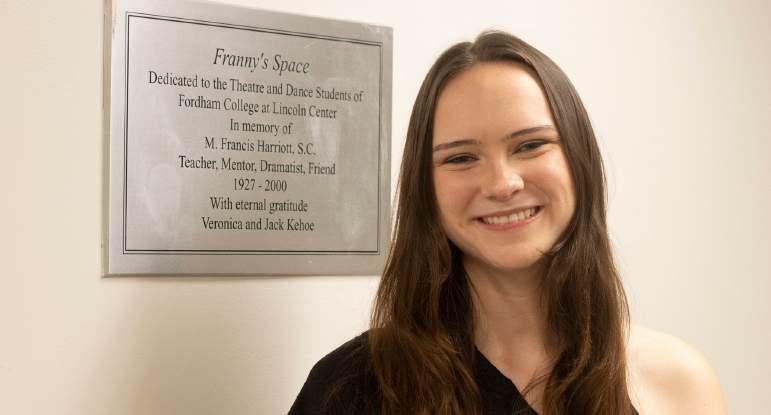

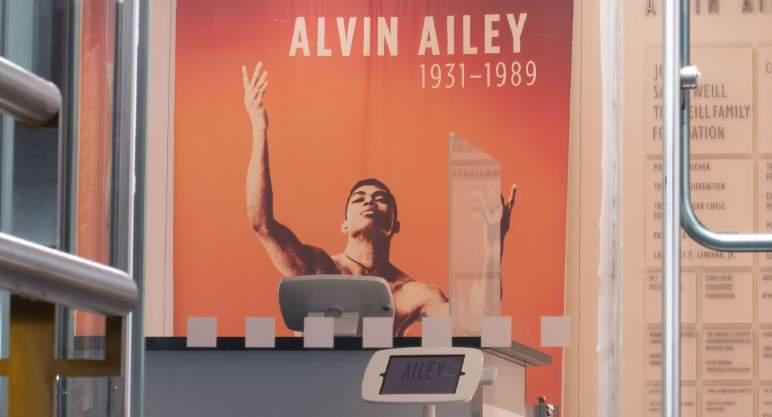
to resolve.
Clark, who is not involved with the negotiations, said he wished he and the other co-director for the BFA program were in the room.
“We have contact with the dancers and the students. We can think about their interests a little bit more readily than the other people,” Clark said.
Strenge started dancing when she was two years old. Growing up in a suburb outside of Boston, she spent countless hours in the studio preparing for regional competition circuits that took her to nationals as a teen. When considering next steps after high school, she knew she was too injury-prone to continue dancing as intensely. But the thought of stepping away altogether was unfathomable
— something she compared to “losing a limb.”
Strenge said that her mother cried tears of joy at the open house thinking that her daughter would get to dance at a preprofessional level while pursuing a business degree.
Once on campus, Strenge dove headfirst into dance. After auditioning to be in the major classes alongside BFA students, she took ballet three times a week and Horton technique twice a week in addition to her regular coursework. She even took content courses normally exclusive to BFA students: “Music for Dancers” and “Black Traditions in American Dance.”
The credits Strenge earned only count as electives, excluding those that fulfilled her fine arts requirement for the
“I would know inside … that I achieved something else,” Strenge said. “But it would be a shame to see all that work and all the extra time and effort I’m putting in not really pay off.”
Still, Strenge remains committed to her pursuit. This semester, she is one of five students in the first choreography class offered at FCLC, which meets weekly in Franny’s Space, the multiuse rehearsal room in the Visual Arts wing. The class is taught by a graduate of the BFA program who is now a professional dancer and choreographer.
Clark visited the class a few weeks ago. He watched the students work through cho-
At least one of the students who signed the minor proposal in support of its creation has already graduated; the rest are current seniors who will soon move on.
reography in different styles of movement.
“I walk into this class and you have five students who are really consciously thinking about what it means to move their bodies … thinking about different traditions, how movements are inscribed in different histories, what the relationship to other bodies is,” Clark said. “(To) see that down in Franny’s Space makes me really happy.”
Clark said it was beautiful to witness, “particularly in this era of ChatGPT.”
Fordham has ramped up science, technology, engineering and math (STEM) and artificial intelligence (AI) initiatives. Last year, the university made headlines for receiving its largest private gift in history — $100 million that will fund a new STEM building on the Rose Hill campus — and recently received a $1 million gift for AI research and innovation.
Even Fordham’s new public image, courtesy of a divisive rebrand, signaled a shift in the Jesuit identity that has guided the university from its inception. Almost 2,000 petition signatories denounced the sleek look in a call to “change back Fordham’s corporatized logo to its true emblem.”
university-wide liberal arts core. With no definitive end to the negotiations in sight, it is unlikely Strenge will complete a formalized dance minor curriculum at Fordham within the time she has left. She would not be the first to leave empty-handed. At least one of the students who signed the minor proposal in support of its creation has already graduated; the rest are current seniors who will soon move on.
Strenge said that just getting to dance at The Ailey School is an advantage in the performing arts world. But walking across the graduation stage without recognition of her rigorous training would be deeply disappointing — especially given that it was the reason she chose Fordham in the first place.
In the dance minor proposal, Clark included quotes about the historic significance of the arts to a Jesuit higher education. He highlighted the salient aspects of the curriculum in comparison to any possible distracting effects of emerging technologies such as AI.
“We’re going to need to have things that bring meaning in really substantive ways,” Clark said. “I think dance is one of those.”
Clark is intent on realizing the program he envisioned, despite the lack of transparency around the protracted financial negotiations that have kept it on ice. He said that at the open house this fall, the most frequently asked question at his table was whether the university had a dance minor.
Following a direction from the head of admissions (who is part of the negotiations), Clark told prospective students it was on hold.
“I think everyone wants it,” he said. “But we need someone to close the deal.”
Billionaires, Aliens and Impending Doom in ‘Bugonia’
By TUCKER FLYNN Opinions Editor
Warning: This review contains spoilers.
Fresh off the heels of 2023’s “Poor Things” and 2024’s “Kinds of Kindness,” Emma Stone and Yorgos Lanthimos are back together for “Bugonia,” also starring Jesse Plemons and Alicia Silverstone.
This campy premise is almost overstuffed with symbolism and allegorical messaging, but career-best performances by Stone and Plemons allow the film to drive home its central claim: Humanity is the problem.
This remake of the 2003 South Korean sci-fi classic “Save the Green Planet” pairs Lanthimos’ signature isolationism with dynamic camera angles and vivid color grading; “Bugonia” seems to exist in a world that mimics our own, albeit with a touch of the surreal.
Over the past decade, Lanthimos and Stone have had a series of high-profile collaborations culminating in the four-time Academy Award winning “Poor Things,” with Stone taking home the trophy for actress in a leading role. As a result, hype for “Bugonia” represents a potential career peak for Lanthimos, and an opportunity for Stone to continue her ascent to superstardom.
The introductory sequence, in which bees pollinate vibrantly colored flowers, drives home the central undercurrent of the film: the fragility of the climate that the human race has so wantonly polluted.
Although the endangered status of bees is only referenced a couple of times throughout the duration of the film’s nearly twohour runtime, buzzing sounds throughout the score serve as a subtle but persistent reminder that despite the antics of individual characters, their environment and society are on the brink of collapse.
Stone plays Michelle Fuller, a wealthy pharmaceutical CEO who is kidnapped by Plemons’ character Teddy and his neurodivergent cousin Don. Her captors are convinced she is a member of the alien race of Andromedons disguised on Earth to destroy humanity. This campy premise is almost overstuffed with symbolism and allegorical messaging, but career-best performances by Stone and Plemons allow the film to drive home its central claim: Humanity is the problem.
Emma Stone’s latest collaboration with Yorgos Lanthimos cements her legacy as a generational talent SERIES AND FESTIVAL HIGHLIGHTS
In fact, “Bugonia” skillfully differentiates between the themes it contains and the message it hopes to convey. Despite discussing abuse of power by police, unethical practices in pharmaceuticals, the disinformation epidemic and the ever-growing gap between what people can be convinced of and what is actually true, “Bugonia” manages to refine its message into a
singular scathing critique of how isolation shapes responses to trauma, and the danger of unproductive responses to injustice.
The opening montage of Michelle’s solitary and almost robotic lifestyle establishes how her wealth and power separate her from the rest of the world. Of course, her alterity is ultimately revealed to be far more literal in the film’s final sequence.
On the other hand, everything about Teddy is equally alien in its own way. The isolating feeling that the film conveys when depicting his daily life and environment cements the significance of managing trauma in isolation as the vector for Teddy’s descent into what initially seems to be paranoid delusion.
This duality initiates a provocative juxtaposition, asking the viewer to consider which side they will choose. Throughout the film, save for a few sinister glances, Michelle is painted as the victim. Her acerbic wit and sarcasm in the face of being chained to a bed in a basement and tortured by a man who has “done his own research” make her an extremely likeable protagonist.
However, it is then revealed that a failed pharmaceutical trial from Michelle’s company left Teddy’s mother, played by Silverstone, comatose in a longterm care facility. Stone’s ability to embody the apathetic performance of regret, paired with the steely resolve of a CEO determined to maintain a bottom line, leaves the audience conflicted, pondering their initial notions of who the protagonist is meant to be.
From there, we are pushed to side with Teddy as a kind of tragic hero, driven to delusion and violence as a result of not only the circumstances surrounding his mother’s illness, but also due to his history of being sexually abused by a childhood babysitter, Casey, played by comedian Stavros Halkias. Casey reappears in Teddy’s life, now under the auspices of his job as a police officer, when he visits Teddy and Don’s house to investigate Michelle’s kidnapping.
Ultimately, the film flips the script again when Don takes his own life. After pleading with Michelle to take him with her to the alien realm and allow him to escape the world that denies his agency and ability to direct his own life, Don commits suicide after she consents.
As such, we as viewers are forced to realize that, within the context of the world Lanthimos has built, it is impossible to choose a side.
This shocking turn of events gives the viewer insight into the true nature of the dynamic of Teddy and Don’s relationship, and how, in his desire to regain control of his own life, Teddy ultimately forced another individual to submit to the same kind of control that he is rebelling against by convincing himself that aliens are lording over the world.
Even more shockingly, Michelle then discovers a secret room in the basement containing
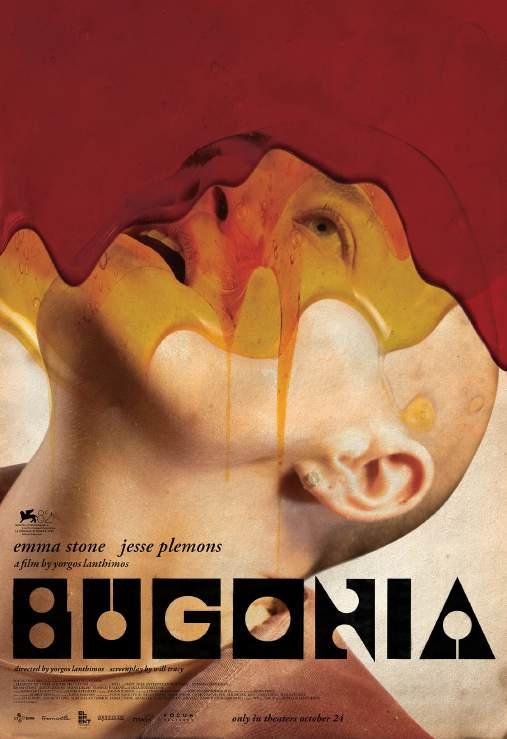

a collection of corpses that reveal the extent of Teddy’s efforts. He had been kidnapping, testing, torturing and dissecting suspected Andromedons for years. While Michelle unravels Teddy’s murderous investigations, Teddy brutally kills Casey, his childhood abuser. As such, we as viewers are forced to realize that, within the context of the world Lanthimos has built, it is impossible to choose a side. It is this subversion of the typical formulaic protagonist-antagonist archetype that allows “Bugonia” to ultimately cement its message. In a collapsing ecosystem where the wealthy exist in a state so separated from the rest of humanity that they become alien, we can expect nothing but the eventual extinction of the human race. Teddy sought renewal, and claimed to want to free the human race from Andromedon control, but all he was able to achieve in the end was self-destruction, as he sought individual satisfacti on at the expense of others.

By SOFIA LAJE Staff Writer
“SENTIMENTAL VALUE” DIR. JOACHIM TRIER (2025)
Alamo Drafthouse Cinema, Angelika Film Center via NEON - Opens Nov. 14
In his first English-language film in ten years, Joachim Trier delivers a 2025 Cannes Film Festival Grand Prix-winning tender family drama. Delivering career-defining performances, the film stars Renate Reinsve, Stellan Skarsgård, Elle Fanning and Inga Ibsdotter Lilleaas. Norwegian, English
“TOKYO STORY” DIR. YASUJIRŌ OZU (1953)
Metrograph via Janus FilmsOpens Nov. 2
Ozu’s quietly devastating postwar classic follows an elderly couple’s visit to their grown children in Tokyo and remains one of film’s most empathetic studies of generational distance and impermanence.
Japanese with English subtitles
“HAMNET” DIR. CHLOÉ ZHAO (2025) BAM, Nitehawk Cinema via Focus Features - Opens Nov. 26
Following wins at the 93rd Academy Awards for both best picture and best director, Zhao adapts Maggie O’Farrell’s bestselling novel into a meditative Shakespearean tragedy, presenting a haunting reflection on art born from grief.
English
“LA CHINOISE” DIR. JEAN-LUC GODARD (1967)
Metrograph via Kino LorberOpens Nov. 7
Before May ’68 erupted in the streets of Paris, Godard imagined it within a singular apartment through a visually stunning dark comedy that follows a group of radical students as they attempt to live out Maoist ideals. French with English subtitles
“PETER HUJAR’S DAY” DIR. IRA SACHS (2025) Film at Lincoln Center, Film Forum via Janus Films and SideshowOpens Nov. 7
Set over a single day in December 1974 in New York with Ben Whishaw as Peter Hujar and Rebecca Hall as Linda Rosenkrantz, Ira Sachs’ latest film is a contemplative portrait of the late photographer: his world, his friends and the creative intimacy of downtown life.
Don’s decision to take his own life reflects the cost of Teddy’s scheming and the danger of repeating the misdeeds of oppressors while repackaging them as something for the greater good. Most importantly, however, Michelle represents the insulation of the ultra-wealthy from the strife and destruction they create. In her life on Earth, she was worlds away from the experience of the average person, and when she makes the climactic decision to eliminate human life on Earth after deeming it a failed experiment, she does so from her far away spaceship, with an action as flippant as popping a bubble.
“Bugonia,” in portraying a satirical, fictionalized Earth, reminds us of our current reality while also poking fun at us for relating to a story about aliens. It also showcases the acting abilities of its two lead actors, Stone and Plemons, as they expertly subvert the audience’s expectations and bring the required nuance to their roles, typical of Lanthimos’ signature exaggerated, ironic narratives.
English
“PUT YOUR SOUL ON YOUR HAND AND WALK” DIR. SEPIDEH FARSI (2025)
IFC Center via Kino Lorber - Opens Nov. 5
Sepideh Farsi immerses her audience in the life and musings of Palestinian photojournalist Fatma Hassona. Through a series of phone calls and Hassona’s own photographs, the intimate documentary conveys the horrors of daily life in Gaza.
English, Arabic with English subtitles
NOIRVEMBER SERIES: SPOTLIGHTING CLASSIC AND MODERN FILMS IN THE FILM NOIR GENRE Quad Cinema - Nov. 3 to 27
Showing “Blue Velvet,” “The Long Goodbye,” “Out of the Past,” “The Big Sleep” Village East by Angelika - Nov. 5 to 26
Showing “Double Indemnity,” “The Maltese Falcon,” “Chinatown,” “Touch of Evil”

un & ames

Crossword: Animal Crossing

34. *Online marketing and automation company with a mascot named Freddie
38. Con
39. Sitcom alien
40. *Animal-viewing excursion and Apple’s default browser, for two (and a hint to this puzzle’s theme)

43. Opposite of WSW
44. Shape made by a comfy cat with its paws and tail tucked underneath itself
46. Have an outsize presence (2 Wds.)
48. Title of a Beatles song, album and movie (3 Wds.)
51. Uninspired name for a Dalmation
52. Bring up
54. Accra’s country
58. Is in low-power mode
61. *Desktop accessory that might have a wrist rest
64. “La Vie en Rose” singer Édith
65. Plays ball
17. Quaint hotels
18. ____ mignon
BY JASMINE WHITE
19. Memo header (Abbr.)
20. *Sacrificial program used to test a computer virus (2 Wds.)
22. ____ corpus
24. Nosy?
25. Brown in the oven 27. Word repeated before “pants on fire” 30. Makes close

Word Waterfall
BY DAMIAN GROVE
67. “Do not go gentle ____ that good night”
68. In addition
69. Like draft beer (2 Wds.)
70. Brown in a pan
71. Underworld river
72. Unwraps, as an orange
73. Saga


1. “It’s __ ____ of the times” (2 Wds.)
2. Salami variety
3. Meemaws
4. Set up, as software
5. Mortgage adjustment (Abbr.)
6. Counterpart to good
7. Paparazzi target (Abbr.)
8. Verb that sounds like its middle letter
9. *Programming language
10. Horse homes
11. Stiles and Ledger rom-com: “10 Things I ___ About You”
41. Hobgoblin
42. Trudges
45. *Web browser
47. Nonbeliever
49. Dance style for Astaire and
50. Chess piece that can only move diagonally
53. Be expressive
55. Sleep disorder
56. Kind of astrological chart

12. Subreddit where posters ask if they were in the wrong (Abbr.)
13. Largest known volcano in our solar system: Olympus ____
21. File type alternatives to GIFs
23. Word following first or financial
26. Knockoffs (Abbr.)
28. “Gotcha!”
29. Rummages
31. Dell competitor
32. “You ____?”




33. Captain Hook’s first mate
34. American Dream or Roosevelt Field, for two
35. Sunburn soother
36. “___ ___ first you don’t succeed” (2 Wds.)



37. Chairman with a Little Red Book




